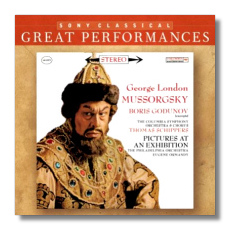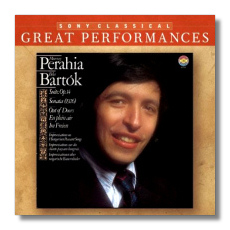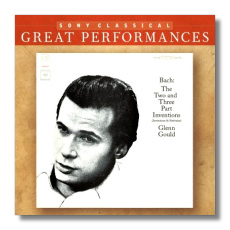
The Internet's Premier Classical Music Source
Related Links
- Latest Reviews
- More Reviews
-
By Composer
-
Collections
DVD & Blu-ray
Books
Concert Reviews
Articles/Interviews
Software
Audio
Search Amazon
Recommended Links
Site News
 CD Review
CD Review
Great Performances

Modest Mussorgsky
- Boris Godunov (excerpts)
- Pictures at an Exhibition (orch. Ravel) *
George London, bass
Mildred Allen, mezzo-soprano
Howard Fried, Stanley Kolk, tenors
Columbia Symphony Orchestra & Chorus/Thomas Schippers
* Philadelphia Orchestra/Eugene Ormandy
Sony Classical 82876-78747-2 ADD 69:58


Béla Bartók
- Sonata (1926)
- Improvisations on Hungarian Peasant Songs, Op. 20
- Suite, Op. 14
- Out of Doors, Sz. 81
- Sonata for Two Pianos and Percussion *
Murray Perahia, piano
* Sir Georg Solti, piano
* David Corkhill, Evelyn Glennie, percussion
Sony Classical 82876-78750-2 ADD 73:42


Johann Sebastian Bach
- Two- and Three-Part Inventions, BWV 772-801
Glenn Gould, piano
Sony Classical 82876-78766-2 ADD 70:02
Here are three CDs in Sony Classical's recently rejuvenated "Great Performances" series. These days, record companies tend to reissue the same old recordings over and over again, so one nice thing about these new "Great Performances" releases is that they bring several older recordings to CD for the very first time. Whether they are new to CD or not, all of the recordings benefit from new digital remasterings, good booklet notes, and even reproductions of the original cover artwork. These are mid-priced titles, which makes them even more attractive.
George London (1920-1985) was the first non-Russian to sing the title role in Boris Godunov at the Bolshoi Theater in Moscow; the year was 1960. Three years later he recorded the complete role, also with the Bolshoi, but before that happened, he recorded excerpts from the role for Columbia Records in 1961. That record (originally MS 6273) finally has been digitally remastered and released on CD. The excerpts are the Coronation Scene, Boris's Act Two monologue ("I have attained the highest power"), the Clock Scene (and the music leading up to it) from Act Two, and Boris's Farewell and Death from Act Four. Brief and competent vocal appearances are made by Mildred Allen (as Fyodor), Howard Fried (as Shuisky), and Stanley Kolk (as the Boyar Khrushchyov). (Even on records, I generally dislike grown women pretending to be boys, however.) The Rimsky-Korsakov orchestrations are used, as one might expect.
London was at close to his vocal best in these excerpts from 1961, and his understanding of the role is complete. In spite of the fact that he was born in Montreal, this is an authentically Russian interpretation. And no wonder: not only was London trained in this role by Russians, one of his earliest musical memories was hearing Chaliapin's record of the Clock Scene. London was born to sing Boris, and this record preserves a large chunk of his interpretation in superior sound. (There's some pre-echo, but not enough to spoil the overall effect.) The chorus is too small for the Coronation Scene, but Schippers conducts knowledgeably. No texts or translations are provided.
Schippers also recorded Pictures at an Exhibition, and I thought Sony BMG might have included it here. Instead, they've used Ormandy's 1966 recording, and it's just as well, even though it has appeared on CD before, because it's a doozy. Like a certain comedian, Ormandy gets "no respect," but this is a superior Pictures - if rather conservative – in every way. (The most questionable moment is Ormandy's fast tempo in "Bydlo.") The Philadelphia Orchestra plays fabulously, and Ormandy, while the soul of efficiency, generates plenty of color and spectacle. The sounds quality has held up very well.
Murray Perahia is not associated with music of the past century – on records, at least, his fame began with Schumann and Mozart, and while he has broadened his discography every year, even Debussy and Ravel are conspicuous by their absence. Surprisingly, Perahia has recorded the music of Béla Bartók. I don't know when Perahia's first sessions for (then) CBS Masterworks were, but as early as 1973 – which must have been near the start of his relationship with the label – he recorded Bartók's 1926 Sonata. That recording must have stayed "in the can" for a while, waiting for the pianist to record more Bartók, which he did in 1976 (Out of Doors) and 1980 (the Suite and the Improvisations on Hungarian Peasant Songs). An LP containing all four works finally was released in 1981. I think this is the first time that its complete contents have appeared on CD. (In contrast, the Sonata for Two Piano and Percussion, recorded with Solti in 1987, and coupled with Brahms' Haydn Variations - in the version for two pianos, of course – has been easy to find since its first release.)
I have great respect for Perahia and should have guessed that his Bartók would be this fine, even if the repertoire is unusual for him. In fact, I think this is one of the best CDs of Bartók's piano music on the market right now – a perfect introductory CD for listeners who "aren't sure" about the music, and a must-have disc for listeners who admire Perahia, Bartók, or (like me) both. What's makes Perahia's Bartók so appealing is the cantabile quality that he brings to it; the music sings. At the same time, Perahia does not ignore the music's more percussive and driving elements, but he doesn't let them take over. His playing is crisp and strong, but it never sounds like a caveman's bashings, which sometimes happens when younger pianists try their hand at this music. Perahia makes the music sound clear and translucent, even in potentially brutal selections such as "The Chase" from Out of Doors. Pairing Perahia and Solti in the Sonata for Two Pianos and Percussion was a brilliant idea – I believe it originated in a performance at the Aldeburgh Festival. Add Evelyn Glennie to the mix (shortly before she became internationally famous) and you've got three celebrities who nevertheless play Bartók's Sonata without ego, but with total dedication to the music. Despite a time-span of almost 14 years, the sound on this CD is consistent and satisfying.
Glenn Gould's recording of the Two- and Three-Part Inventions (also known as "Inventions and Sinfonias") by Bach dates from 1964. Listeners already familiar with Gould's other Bach recordings will find little to surprise them here. Cumulatively, the idiosyncratic tempo choices, the détaché articulation, the way in which each performance seems to be taking an x-ray of the music, and even the pianist's penchant for singing along could belong to no one else, in spite of Gould's followers and imitators. This time around, Gould is aided and abetted by "a pre-World War II Steinway which answers to CD 318," for which Gould felt "a greater devotion than to any other piano that I have encountered." Hearing this piano for the first time, one might well wonder if either the CD or the CD player is malfunctioning. Gould's physical modifications to this instrument, calculated to create a piano more harpsichord-like in its "clarity and tactile felicity," have produced a minor sonic "after-effect" as idiosyncratic as his playing. His own description of the result could hardly be bettered: "a slight nervous tic in the middle register which in slower passages can be heard emitting a sort of hiccup." Once one becomes accustomed to it – if one becomes accustomed to it, that is – it becomes just another component of Gould's overall approach, and it makes a twisted kind of sense.
Gould's decision to pair each invention with the sinfonia in the same key can be justified on the basis of Bach's 1723 manuscript of these works, in which precisely the same thing is done. Gould's ordering is strange, however; after starting with #1 and 2, sensibly enough (the C Major and C minor pairs), he jumps to #5 (E Flat Major), then #14 (B Flat Major), #11 (G minor), and so on. This didn't really bother me, but it does subvert Bach's stepwise progress through the different keys, and it also creates a lot of page-flipping, if one is following along with a score.
Gould's fans will rejoice at the interesting bonus offered on this CD: monaural recordings of the F-major, B-minor, and F-minor Sinfonias dating from June 1955, during the famous sessions when Gould was making his first recording of the Goldberg Variations. This is their first release. And, because the tape kept on rolling, we're also given unedited studio session takes of the same three sinfonias. We hear Gould intently run through each of the three sinfonias several times, usually with just a few words from him and the producer between each take. The inclusion of these out-takes doesn't really tell us that much about Gould's working methods, but it is fun to be a fly on the wall!
Copyright © 2006, Raymond Tuttle




















